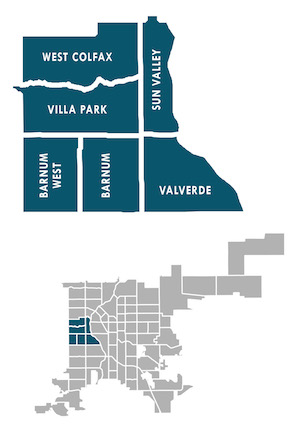
Started in 2019, The West Area Plan is nearing its final stages and city planners are again looking for residents to give input on the future of their community. These plans encompass several neighborhoods and allow the city to look at aspects ranging from housing to transportation, to environmental issues, to overall quality of life. From there, the various agencies can implement specific policies and projects based on the plans.
Sound broadscoped? It is. These plans are ultimately the basis for decisions about zoning density, mass transit vs car vs bike and pedestrian options, arts and cultural spending, and much more.
The West Area Plan includes the West Colfax, Sun Valley, Villa Park, Valverde, Barnum, and Barnum West neighborhoods. If you live in more northern neighborhoods, this is also a chance to preview what the Near Northwest Area Plan may look like in another year and a half and to better understand that process.
This month the city is rolling out more details, including specifics on priorities identified through their research and community feedback. Among those priorities are a number of topics that come up frequently. Senior City Planner Eugene Howard and Alexandra Foster, the communications program manager for Community Planning and Development, talked with The Denver North Star to help explain some of those priorities and how the community can give input.
Preservation and Reuse of Existing Buildings
Denver’s Westside hasn’t seen the volume of scrapes as the Northside, and preserving structures is a priority for both the city and residents. While specifics on policy proposals are still a few months away and involve various departments, Howard explained some examples could include ideas as simple as streamlining review and permitting for older buildings owners are trying to repurpose. Right now, it can be cheaper for a developer to knock down and rebuild rather than renovate, which they can work to change. “Time is money in the development world,” he explained. “If a building meets the definition of Historic with a capital H, it can unlock financial tools.” Those tools could include city, state, or private grants, making repurposing more affordable. An older church or school no longer being used can be converted into housing or small businesses but it keeps the external appearance the community knows. He describes it as “Not just saving a building, but the overall character.”
Access to Healthy Food
Addressing food deserts, areas that don’t have easy access to purchasing an array of foods, has also been identified as a priority. While infill projects and zoning that allow grocery stores and encouraging them to open is one obvious solution, Howard explained that based on feedback, especially from older residents, the city is also exploring how they can support alternative options like food delivery services, mobile pop-up markets, and other options that make food more available without car travel.
While long term plans are important, Foster said they also hear from people who say their needs are more immediate, and the community outreach has also been a way planners can connect people with city agencies working with food and housing insecurities in the short term as well.
Improved Transportation Options
Colfax Avenue itself is technically a highway, but the growth of fun new businesses means it’s also increasingly a destination area for residents looking to enjoy an evening out on foot or bike. As Denver’s suburbs continue to grow, the road is also a major route from Jefferson County into the heart of Denver. Among the priorities listed is Bus-Rapid Transit (BRT) on Colfax as well as improved bus service on Sheridan and Federal. The city also lists multiple bicycle and pedestrian improvements aimed at making travel in the area both safer and more enjoyable. Howard explained that as both Denver and the suburbs grow, the city needs to be better able to move large volumes of people and give more options than a single occupancy car.
Your Chance to Weigh In
The topics above are only a fraction of the issues raised in the 19 categories, each with multiple points. Also, while the plan is at the stage of some specifics, the next few months are possibly the most important phase, as priority ideas start becoming actionable items. Residents, business owners, and people who spent time in these communities are all encouraged to give more feedback, which can be done multiple ways.
More information is available at DenverGov.org/westplan and will be presented at community meetings.
- Online Survey. The easiest way to engage is likely via online survey available on the city’s website.
- Ask for a presentation to your group! If you are part of a community organization interested in hearing more and giving feedback, the Community Planning and Development staff is eager to meet with you all (mostly virtual for now, but in-person later this year).
- Planned community meetings. The city will be looking at more in person meetings as public safety orders allow this summer, and are continuing online meetings for now. The department is also planning more door to door outreach this summer, understanding that not everyone has access to a computer (or chooses not to engage online).
- In the meantime, the next steering committee meeting will be May 20th, and a link can be found on the West Area Plan page. The community is invited to watch.
Note: We’d like to thank Alexandra Foster, Eugene Howard, and the CPD team for making files available and talking with us before information was released publicly in order to help facilitate getting this story finished in time for publication. As a monthly newspaper, we strive to keep the community updated and appreciate staff’s flexibility in helping us meet that goal on deadlines.

Be the first to comment